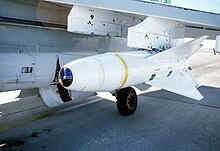
Optical contrast seekers, or simply contrast seekers, are a type of missile guidance system using a television camera as its primary input. The camera is initially pointed at a target and then locked on, allowing the missile to fly to its target by keeping the image stable within the camera's field of view.
The first production missile to use a contrast seeker was the AGM-65 Maverick, which began development in the 1960s and entered service in 1972. The system has not been widely used, as other guidance technologies like laser guidance and GPS have become more common, but the same basic concept is used in cameras to track objects, including the systems used to aim the laser designators.
Contrast seekers should be distinguished from television guidance systems, in which a live television signal is broadcast to the launch platform, which then uses manual direction to attack the target. Examples of TV guidance include the Martel and AGM-62 Walleye. The term "contrast contour" is sometimes used, but this may be confused with TERCOM systems.
